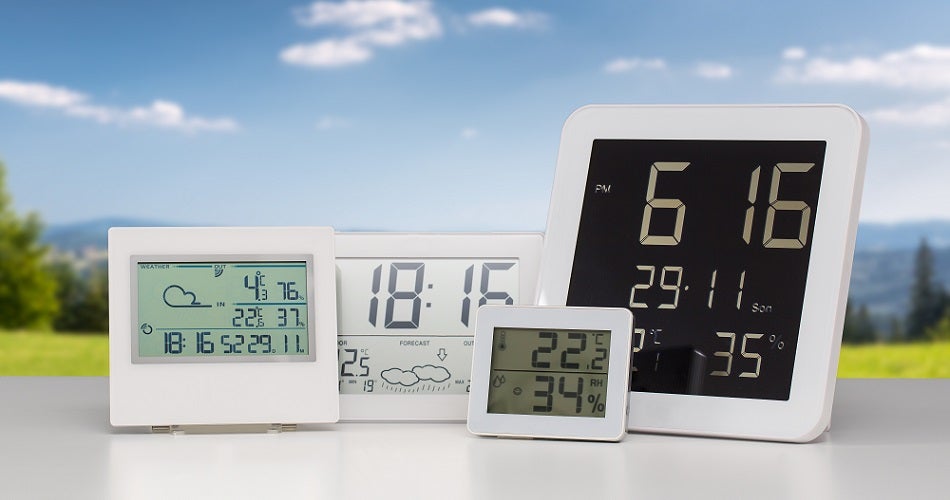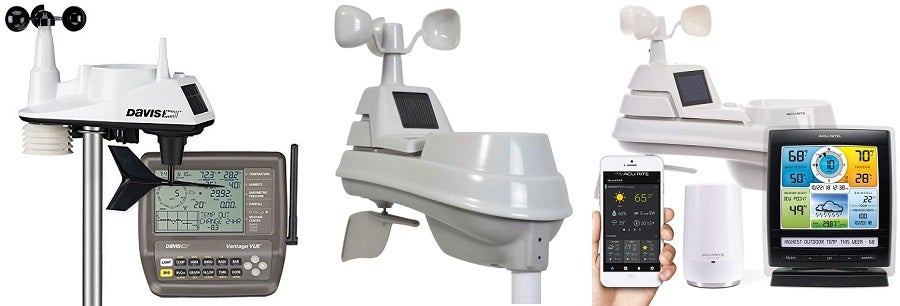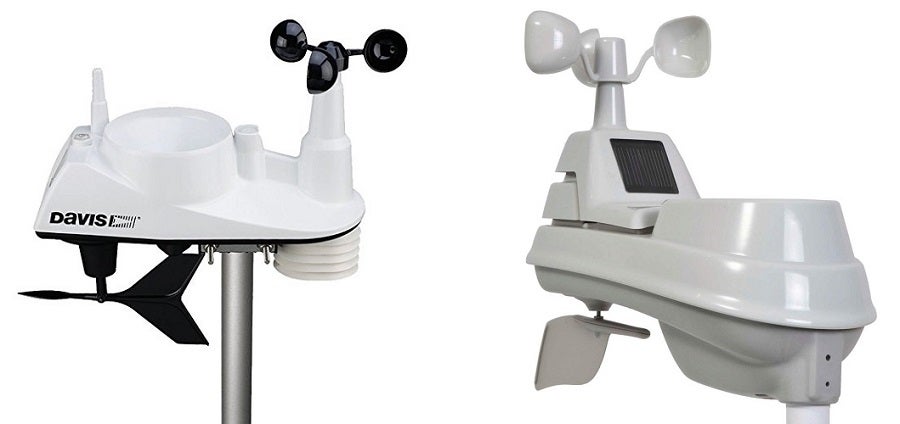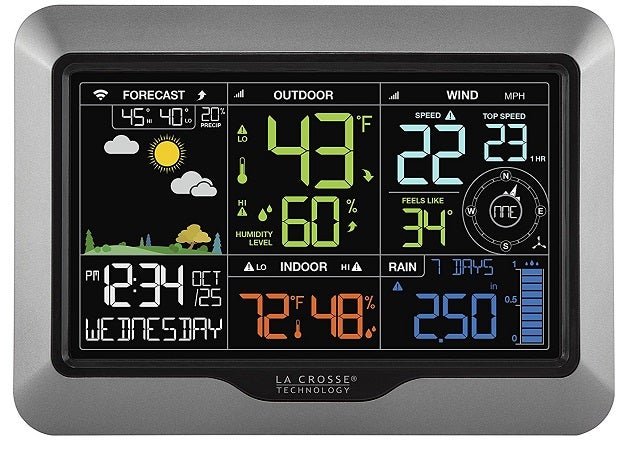
Our Editors independently research, test, and rate what we feel are the best products. We use affiliate links and may receive a small commission on purchases.
Whether you’re a farmer, gardener, hobbyist or a budding meteorologist, it’s never been easier to have an in-depth understanding of the environment around you. The best home weather stations can provide you with the important data that you need such as temperature, pressure, humidity, wind speed and much more. The latest weather stations can be complex, and it can take some research to understand which one is right for your needs. We’re going to review several of the top stations currently on the market and look at the most important factors in home weather stations!
Best Home Weather Stations
Quick Answer: The Top Rated Home Weather Stations
- Ambient Weather WS-2902A Wi-Fi Professional Weather Station
- Davis Instruments 6250 Vantage Vue Wireless Weather Station
- AcuRite 02064 Color Weather Station Forecaster
- Tempest Home Weather System
- La Crosse Technology V40- Professional Weather Station
- AcuRite 01012M Weather Station
- ThermoPro TP65 Digital Wireless Hygrometer
Home Weather Station Reviews
#1 Editor’s Choice – Ambient Weather Professional Weather Station
- Display: Color Film LCD
- Measures: Wind speed & direction, rainfall, outdoor temperature, solar radiation, UV, humidity and barometric pressure
- Internet Connectivity: WiFi (2.4 GHz)
- Power: Solar, with 2 AA batteries for backup
- Applications: “Ambient Weather Dashboard” App available for Android and iOS
- Mounting: The station mounts to any poles from 1″- 2″ diameter
- Other: Compatible with Alexa, 1 year warranty
If you’re looking for the best weather station, this professional option brings data to life with a truly modern touch. This Ambient Weather station is equipped with the tools necessary to measure wind speed, wind direction, rainfall, outdoor temperature and humidity, solar radiation, dew point, wind chill and heat index. The Ambient Weather station has been well reviewed for its looks and quality, and is a reliable option that provides plenty of data to help you understand the local weather.
The data collected by the weather station can be accessed on-the-go via your preferred digital device, whether that’s your computer, tablet or smartphone. You can even export the data to spreadsheets if required, which is a nice touch for enthusiasts.
With Alexa compatibility, a world of opportunity is opened for your smart home. Via the app, it’s possible to easily program “if this, then that” functions. This simply means that you can execute actions in certain circumstances. For example, if no rain is forecast for a set period of time, you can automatically trigger sprinklers on your lawn.
#2 Runner Up – Davis Instruments Vantage Vue Wireless Weather Station
- Display: Backlit, 3 by 4.375-inch LCD display
- Measures: Temperature, humidity, barometric pressure, wind speed and direction, dew point, moon phase, sunrise/sunset times and rainfall
- Accuracy: Records wind speed from 2 mph – 150 mph
- Rapid Updates: Updates refresh every 2.5 seconds
- Power: Solar power with lithium batteries for failsafe
- Other: 1 year warranty
The Vantage Vue weather station from Davis Instruments comes with the Integrated Sensor Suite (ISS), an LCD console and the mounting hardware. This is everything you’ll need to begin tracking the weather with accuracy and reliability. This weather station provides accurate readings for a range of weather conditions such as indoor and outdoor temperatures, humidity, barometric pressure, wind speed and direction, dew point and rainfall.
While the wireless home weather station lacks the accessibility and data management capacities of the Ambient Weather model above, it does boast fast updates from the ISS to the console every 2.5 seconds, and up to an impressive distance of 100 yards. This means that within minutes, you can use the simple console to enjoy weather forecasting, moon phase and sunrise/sunset times, graphing of weather trends, alarms and more!
#3 Best for Convenience – AcuRite 02064 Color Weather Station Forecaster
- Display: Illuminated Color Display with Auto-dimming Backlight
- Measures: Weather Forecast, Temperature. Humidity. Barometric Pressure, Moon Phase, Intelli-Time Clock and Date
- Design: Weather-resistant and works down to -40 degrees
- Transmission: Wireless data transmission up to 330 feet
- Other: 1 year warranty
This AcuRite digital weather station places emphasis on convenience and simplicity. The large illuminated display has an auto-dimming feature which clearly provides you with the key information you need on a 12 to 24-hour schedule. At a glance, you’ll be able to get reliable and accurate weather forecasts whether it’s sunny, partly cloudy, cloudy, and if there’s a chance of rain, snow or a combination of both.
This weather station is small, discreet and is capable of tracking the temperature and humidity both indoors and outdoors. You’ll also be able to track moon cycles as well as the date and time. The sensor is simple and fast to install. Once it’s up and running, AcuRite’s patented self-calibrating weather forecaster will enter its 14-day learning mode in order to determine your altitude and deliver the most accurate readings possible.
#4 Best Wireless – Tempest Home Weather System
- Display: Smart phone/tablet
- Measures: Temperature, humidity, wind speed, wind direction, rain and more
- Applications: Tempest app for Android and iOS
- Readings: 5-in-1 weather sensor
- Design: Strong and durable, functions down to -35 degrees
- Connectivity: Transmits up to 1000 feet
Probably the most futuristic weather station on our list, the Tempest Home Weather System is an advanced personal WiFi weather station. It’s capable of accurately measuring over ten different weather conditions including rainfall, wind speed, wind direction, outdoor temperature and humidity. This means that rather than relying upon readings from news networks or the internet, amateur meteorologists can now create their own personalized weather forecasts generated right from their backyard. One unique feature of the Tempest is there are no moving parts, even for the wind sensor. This is a nice bonus since there’s nothing to break!
To view weather data, you have to download the Tempest app on your smartphone or tablet. Once you have the app, it will take you through a simple setup process that takes about a minute, and you’re ready to go! This allows the user to view their data from anywhere around the world, set up programmable alerts and more. The app will toggle to the local weather from Weather.com, so you can compare your results for accuracy. It also keeps a record of history so you can see weather trends. Keep in mind that the only way to view data is with the Tempest app, so you must have a smart phone or tablet. This is by far one of the best wireless home weather stations currently on the market!
#5 Most Accurate – La Crosse V40-PRO-INT Professional Weather Station
- Display: LCD: 6.5″L x 3.75″H
- Measures: Wind speed & direction, rainfall, outdoor temperature, solar radiation, UV, humidity and barometric pressure
- Connectivity: Up to 400 ft range
- Applications: La Crosse View Android and iOS app
- Power: Power cord, 2 AA batteries for backup
- Other: 1 year limited warranty for parts and labor
This Wi-Fi weather station has been well reviewed for the accuracy of its readings, and the rich set of features that it offers given the attractive price. As such, it’s the most accurate home weather station on our list. Offering an attractive blend of engineering, design and functionality, the system tracks temperature, humidity, rainfall, wind speed and wind direction. All of this information is clearly presented on the large, high-quality screen. This makes for simple analysis to help plan your day and any activities which may be affected by the weather.
Unlike many of the other models on our list, the temperature gauge is kept separately from the rest of the monitors. This improves its accuracy and gives the user flexibility when it comes to choosing where they place it, so you’re able to get the most accurate reading.
#6 Customer’s Choice – AcuRite 01012M Weather Station
- Display: Backlit LCD display
- Measures: Temperature, humidity, barometric pressure, wind speed and direction, dew point, moon phase, sunrise/sunset times and rainfall
- Distance: Transmits up to 330 feet
- Compatibility: Compatible with up to seven AcuRead devices
- Power: Battery backup
- Other: Compatible with Alexa
Another AcuRite weather station on our list, the 01012M model comes with a range of unique features. These features really make the digital weather station a practical device which can shape your day-to-day decisions and keep you informed. The emphasis on practicality is achieved through compatibility with up to seven AcuRead devices.
This means that through water and wind sensors, for example, you’re able to get moment-by-moment updates on what’s happening in your home while you’re away. The device is also further integrated into everyday life by its functionality with Amazon’s Alexa system. Weather updates can also be shared with your friends and family, as well as popular online weather communities such as Underground.
#7 Best Budget – ThermoPro TP65 Digital Wireless Hygrometer
- Display: 4” backlit LCD touchscreen display
- Measures: Hygrometer thermometer measures indoor/outdoor temperatures & humidity
- Connectivity: Humidity monitor with 200ft/60m remote range, capable of strong signal penetration
- Frequency: Readings taken every 30 seconds
- Multiple Readings: Potential for up to 3 remote sensors (one included as standard)
Last but not least, if you’re looking for the best budget weather station, this feature-packed wireless option could be the one for you. The package comes with one remote sensor as standard, though it can support readings from up to three at any one time.
The sensor is capable of transmitting accurate temperature and humidity ratings to the attractive LCD display, which is easy to read and can be operated via a touchscreen. The affordability of this product makes it a particularly attractive option, despite the fact that it pales in comparison to its competitors in terms of the complex variety of readings it can offer.
Home Weather Station Comparison Table
| Measurements | Internet | WiFi Range | App | ||
|---|---|---|---|---|---|
| Ambient Weather Professional | 10 | Yes | 330 ft | iOS / Android | |
| Davis Instruments Vantage Vue | 7 | No | 1000 ft | None | |
| AcuRite 02064 Color Weather Station Forecaster | 5 | No | 330 ft | None | |
| Tempest Home Weather System | 5 | Yes | 1000 ft | iOS / Android | |
| La Crosse V40-PRO-INT | 7 | Yes | 400 ft | iOS / Android | |
| AcuRite 01012M Station | 7 | Yes | 330 ft | iOS / Android | |
| ThermoPro TP65 Digital | 3 | No | 200 ft | None |
How to Choose the Best Weather Station

Given that you’ve already started your research, you’ve probably noticed just how many options are out there when it comes to weather stations. There are countless brands and prices, so it can be difficult to get an accurate reading on which is the best one for you! Here’s a quick guide on what you should take into consideration when browsing for the best personal weather station.
Features
As you know, weather stations come packed with a wide range of features. Depending on your priorities and goals, these could range from a killer, must-have feature to an unnecessary additional cost. That’s why it’s important to assess what your needs are in terms of features. Think about what you’ll use your weather station for. For example, if you’re going to use it in an attempt to have a luscious green lawn, then you’ll want a station that’s capable of measuring and predicting rainfall. If you’re pushing things to the next level, maybe you’ll want your station to provide alerts which trigger sprinklers.
On the other hand, if you’re using your weather station to assist in your stargazing activities, you may want one that can offer accurate moon phase readings while providing accurate predictions of cloud coverage on any given day. Thinking about your specific needs can help narrow down your choices to just a few models, making your search much easier.

Accuracy
The best stations command the highest prices because they offer the best in terms of quality, dependability and accuracy. Are you willing to make a sacrifice in terms of accuracy, or do you need pin-point readings that never let you down? This is an important question to ask when beginning your research. If you’re willing to accept readings which are slightly inaccurate, you’ll find that more affordable models are a good option. If, on the other hand, your readings must be extremely accurate, you’ll be looking at the top-tier range of weather stations.
Expandability
If you’re set on making a significant investment in a weather station, it’s worth considering what options there are for future growth of the system. Many weather stations offer a series of probes which can be attached to the system, or they can receive readings from a range of transmitters such as the ThermoPro TP65 above.
Screens
The suitability for data collection is important, but so is the way that you view and interpret that data. Weather stations vary wildly in terms of the displays and applications that they offer, and this can be a significant consideration that you have to make. AcuRite devices, for example, have an application ecosystem which can be used to sift through the data you’ve collected.
Weather stations also vary in terms of size, quality, and the type of screens that they offer. If you’d like a weather station to simply get an accurate reading on the temperature outside before you head out, a simpler screen with clear data visibility should do the trick.
Budget
It’s always good practice to establish a maximum amount that you’d like to spend. This is also the same when it comes to shopping for a weather station, many of which can quickly reach into the hundreds if you’re looking at high-precision, professional models.
Tips For Using Your Home Weather Station
You may be new to the world of weather stations, and there’s certainly a lot of best practices you should follow to get the most out of your new purchase. To help you get accurate readings, be sure to follow these essential tips.
#1: Place the thermometer in the shade
A common mistake that new weather station owners make is to place the thermometer in the wrong location, which can result in inaccurate readings. It’s best practice to place the thermometer in the shade so that it reads ambient temperature without being heated by the sun. Not only will this lead to inaccurate readings, it can also speed up the degradation process of the components found inside.
#2: Consider mounting options before buying
Where are you planning on placing your weather station? Whether you’re planning on placing it on your roof, on a wall, or simply inside your home, you’ll need to put some thought into how it’s going to be mounted. While some weather stations come with all of the necessary mounting equipment, many don’t so you’ll need to make those purchases separately.
#3: Share your information
Weather underground is a commercial weather service which gives real-time weather updates via the internet. It’s a fascinating project in that the information not only comes from the National Weather Service (NWS), but also from over 250,000 personal weather stations.
It’s a wonderful project that has been in operation for over 20 years, it has a lot of uses and can keep people safe. There are a variety of ways that you can share the data from your personal weather station with the platform, and enthusiasts will also be able to help you out.
Conclusion
Whatever your reason for deciding to purchase a personal weather station, we hope that this guide has helped you and can lead you to the right decision. They really are incredible pieces of technology for outdoor enthusiasts, and it helps to bring us all closer to the innerworkings of the environment.
FAQs
What is the best weather station for home use?
Our pick for the best home weather station is our Editor’s Choice, the Ambient Weather Professional Weather Station.
How do weather stations work?
Weather stations contain digital displays that can measure indoor and outdoor temperatures, barometric pressure, humidity, wind speed and more. Many are able to transmit this data through a wireless network which can be accessible on your smartphone, while others include a thermometer to give you clear results.
How much do home weather stations cost?
Of course there are differences in the build quality and accuracy according to price, but that doesn’t necessarily mean that cheaper weather stations can’t provide useful measurements. Affordable alternatives (like the ThermoPro TP65 Digital Wireless Hygrometer for under $30) offer a simple option for first-time weather station buyers. However, many higher quality weather stations with specialized features range from $150 to upwards of $300.
How long do weather stations last?
You’ll find that the majority of weather stations do come with a standard manufacturer’s warranty of one year. Some manufacturers offer special promotions whereby registering your product gives you an extended warranty, so be sure to keep your eyes open for those deals.
Are weather stations difficult to get set up?
This will largely depend on where you want to mount your weather station, but generally you’ll find that they’re a breeze to use. Many leading manufacturers have simple pairing processes with other devices, and they can provide quick and easy results straight out of the box. Some weather stations do have a calibration period, but this is automatic and you’ll be able to learn more about it on a case-by-case basis.
How far away can the sensor be placed?
This will vary from model to model, but the general average is around 300-400 feet. You should also pay attention to the strength of the signal, though. Even though some models claim to offer 300 feet of range, this can be reduced significantly depending on the materials which are placed in the way. Be on the lookout for additional information about the strength of the signal.
How often do weather stations relay information?
This is something which again varies from model to model. Naturally, the faster the refresh rate, the more data you will have available to you. If you’re an enthusiast who needs to get a regular and consistent idea of various elements, stay on the lookout for models that send data to the receiver more frequently.
How We Researched
To come up with the top personal weather stations, we researched a variety of sources for reviews such as Home Depot, Lowes, Target and Wayfair, along with our own personal experience. We also consulted online magazines for product research and reviews to get as much unbiased information as we could. To help weed out fake reviews we used Fakespot.com to make sure we only looked at genuine reviews. With so much quality gear available, we had to narrow it down based on what we felt were the best options were for the price. The staff authors have a wide and varied background in yard design and home repairs.
The authors have decades of experience and are eager to share their knowledge with readers. To help narrow down the selection, we used personal experiences along with recommendations from landscapers, bloggers and contractors. After extensive research, we came up with our list to help you choose the right one for you.
Recent Updates
March 9, 2022: Verified availability of all products. Added more FAQs to address popular consumer queries.


There seems to be a design flaw with the AccuRite 01012M Station (Number 6 on your list). We purchased this system 3 years ago. After 1.5 years, we noticed a degradation in performance. A plastic shield guarding the solar collection surface became opaque due to (ironically enough) weathering and sunlight exposure. This forced us to replace the batteries (4 AA’s) on a monthly basis. This involved getting on the roof and taking the machine down etc.
Also, right after we got it, there was a record storm and the machine failed to record the rainfall and wind speeds/